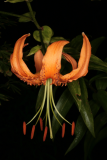Additional notes (click to expand)
Commemorative
This commemorates Dr Augustine Henry (1857– 1930) who collected plants in China and Taiwan
while working for Britain’s Imperial Customs Service. He discovered this orange-flowered lily in his travels. He was of Irish stock, and was educated in Ireland, but qualified in medicine in Edinburgh
and became a fluent speaker of Chinese. He arrived in Shanghai in 1881 and from 1882–9 he was assistant medical offi cer in Yichang. He collected extensively in Szechuan and Hubei. He was posted to the island of Huinan (modern-day Hainan), where he collected 750 plants, but was invalided home with malaria. He was transferred to Taiwan (1892–4) where he made further collections and published Notes on economic botany in China (1893). He returned to England, studied law and became a member of the Middle Temple, but after a year returned to China as acting chief commissioner of customs from 1895–1900. He continued collecting. In total, he sent
back 15,000 herbarium specimens and 500 plants to Kew, from which 25 new genera and 500
new species were described, but it was EH Wilson who later sent back living specimens of these
plants. The next two years were spent at Kew and at the French National School of Forestry at
Nancy, during which he commenced to co-author (with HJ Elwes) Trees of Great Britain and
Ireland (7 vols, 1913). He became professor of forestry at Cambridge University, (1907–13),
then professor of forestry at the Royal College of Science (merged into University College in
1926), Dublin, until his retirement in 1927. His personal herbarium of 10,000 specimens was
bequeathed to the National Botanic Gardens, Glasnevin.
Oakeley, Dr. Henry. (2012). Doctors in the Medicinal Garden. Plants named after physicians. Royal College of Physicians. page 97
link
Horticulture
Lilium henryi is a bulbous perennial in the family Liliaceae originating from China. It is planted deeply in a well-drained, fertile raised bed under trees, where it produces tall stems of lightly scented, orange, spotted, Turk’s-cap style flowers in late summer. The stems are lax so they may benefit from staking. In early spring, they are mulched with well-rotted manure (Clare Beacham).
Oakeley, Dr. Henry. (2012). Doctors in the Medicinal Garden. Plants named after physicians. Royal College of Physicians.
link
Medicinal
In traditional medicine the related species L. candidum, the Madonna lily, has a long history of herbal use, though it is seldom employed in modern herbalism because of its scarcity. The bulb and the flowers are astringent, highly demulcent, emmenagogue, emollient and expectorant. The plant is mainly used externally, being applied as a poultice to tumours, ulcers, external inflammations etc. The bulb is harvested in August and can be used fresh or dried. The flowers are harvested when fully open and used fresh for making juice, ointments or tinctures[Bown. D. Encyclopaedia of Herbs and their Uses. Dorling Kindersley, London. 1995]. The pollen has been used in the treatment of epilepsy[Chopra. R. N., Nayar. S. L. and Chopra. I. C. Glossary of Indian Medicinal Plants (Including the Supplement). Council of Scientific and Industrial Research, New Delhi. 1986].
https://pfaf.org https://pfaf.org/User/plant.aspx?latinname=Lilium+candidum
Nomenclature
Other use
Henry brought Lilium henryi with him when he left Yichang in 1889 and gave some to Charles Ford, who forwarded some to Kew. It is widely cultivated today and is lime-tolerant. Hybrids with the ‘Trumpet’ lilies produced the line of late-blooming ‘Sunburst’ lilies. We also grow Rubus henryi var bambusarum and the creeper, Parthenocissus henryana.
Oakeley, Dr. Henry. (2012). Doctors in the Medicinal Garden. Plants named after physicians. Royal College of Physicians.
link
Geographical distribution
- Asia-Temperate, China
Lilium henryi
Family: LILIACEAEGenus: Lilium
Species: henryi
Common names: Henry's Lily
Distribution summary: China
Habit: Perennial
Garden status: Currently grown
Garden location: Plants of the World (B)
Reason for growing: Commemorative




.JPG)